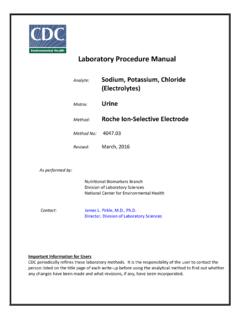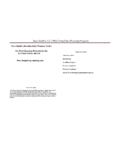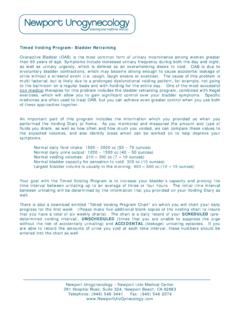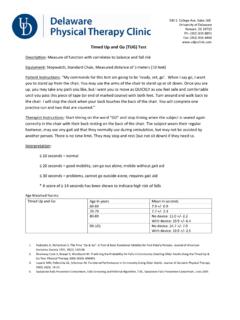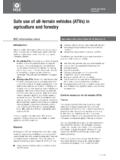Transcription of NHANES: Aalytic Guidelines, 2011-2014 and 2015-2016
1 National Health and Nutrition Examination Survey: Analytic Guidelines, 2011-2014 and 2015-2016 . December 14, 2018. Table of Contents 1. Introduction 2. Data considerations Sample design changes for the 2011-2014 and 2015-2018 samples Race and Hispanic origin variables Disclosure assessment Age Place of birth Pregnancy status Survey subsamples Fasting subsample and oral glucose tolerance test subsample Environmental subsamples Geography Season Combining NHANES survey cycles Missing data Unit or sample person non-response Component or item non-response Value codes 3. Analytic considerations Sample weights Determining the appropriate sample weights for analysis Subsample weights Combining survey cycles 1999-2002 NHANES. Computing population counts Variance estimation Methods Other sources of variability Subsetting data Statistical precision of estimates 2.
2 Sample size Relative standard error Reliability of the estimated standard error and degrees of freedom Confidence intervals 4. Conclusion 5. References Text Tables Table A. Unweighted sample sizes (percentages) by race and Hispanic origin for examined participants, NHANES 2007-2010, 2011-2014 and 2015-2016 . Table B. Age-related variables on public data files, NHANES 2007-2010 and 2011-2014 . Table C. NHANES 2011-2016 subsamples Table D. Overall unweighted survey response rates for all ages, NHANES 1999-2016. Table E. Distribution of MEC sample weights by race and Hispanic origin and survey years Table F. Formulae for constructing weights for NHANES. 3. 1. Introduction This report presents information regarding the analytic and reporting guidelines for the NHANES. 2011-2012, 2013-2014, and 2015-2016 publicly released data.
3 This report builds upon earlier published guidelines1, but also includes revisions to the general guidelines for the statistical presentation of proportions2. The report will be updated to include the 2017-2018 cycle of NHANES upon the release of the public-use data in 2019. The statistical guidelines in this document and earlier published guidelines are not standards. Depending on the subject matter and statistical efficiency, specific analyses may depart from these guidelines. In conducting analyses, the analyst needs to use her or his subject matter knowledge (including knowledge of methodological issues), as well as information about the survey design. Design-based statistical methods are primarily used for NHANES data when producing NCHS. reports and other analytic products. Design-based methods explicitly take into account features of the survey design, such as differential selection probabilities and geographic clustering.
4 Model- based approaches have been used with sample surveys; however, the specific application of these methods relate to the analysis objectives and are beyond the scope of this document. In all analyses, the less a method incorporates the sample design, the more important it is to evaluate the results carefully and to interpret the findings appropriately. In addition to these and earlier Analytic Guidelines, specific data file documentation can be found via the link next to the respective data file on the NHANES website3. This documentation is always the most up-to-date source of information about the variables on each data file. Although not anticipated, some information about specific variables contained in this report may be updated. In 4. addition, another resource for all analysts is the series of NHANES Tutorials4 a Web-based product designed to assist users in understanding and analyzing NHANES data.
5 2. Data considerations The 2011-2014 and the 2015-2018 NHANES four-year sample designs allow for the production of aggregate-level national estimates. Data files are publicly released in 2-year cycles and the survey content within those years is fixed to the extent possible. While annual NHANES samples are nationally representative, estimates for single-year data are relatively unstable (have large variance estimates) since NHANES can only survey a small number of locations each year. Importantly, although data are released in 2-year cycles, data from any one NHANES cycle may not be sufficient for certain analyses, such as those that examine subsamples or outcomes with low prevalence. For this reason, combining cycles into samples of four years or more is recommended whenever possible. However, please note differences in survey content between 2-year cycles and between sample designs when combining 2 or more cycles of data.
6 Not all NHANES data are publicly released. Some restricted data described below are only available through the NCHS Research Data Center (RDC)5. For example, in addition to low precision, releasing only one year of data increases the possibility of disclosing a sample person's identity; therefore, annual samples are only available in the RDC. Sample design changes for the 2011-2014 and 2015-2018 samples NHANES is designed to produce stable prevalence estimates for population subgroups (domains). defined by age group, sex, low-income status, and race and Hispanic origin. The subgroups of particular public health interest have changed over time. Oversampling is done to increase the 5. reliability and precision of estimates of health status indicators for these population subgroups. Sample weights allow estimates from these subgroups to be combined to obtain national estimates that reflect the relative proportions of these groups in the population as a whole.
7 For NHANES 2011-2014 , the design was changed to oversample Asian persons, in addition to the ongoing oversample of Hispanic persons, non-Hispanic black persons, older adults, and low income white and Other persons. The Other race subgroup included those who reported a race other than black, white, or Asian or those who reported more than one race. Specifically, the oversampled subgroups, also called domains, in the 2011-2014 survey were as follows: Hispanic persons;. Non-Hispanic black persons;. Non-Hispanic non-black Asian persons;. Non-Hispanic white persons and persons of Other races at or below 130 percent of the federal poverty level; and Non-Hispanic white persons and persons of Other races aged 80 years and over. In the 2015-2016 sample design, these same groups continued to be oversampled. However, the income threshold for the low-income white and Other persons group was changed from at or below 130 percent of the federal poverty level to at or below 185 percent of the federal poverty level.
8 6. For the 2011-2014 , and the 2015-2018 sample designs, the Hispanic category included all persons who reported to be of Hispanic ethnicity regardless of race. The non-Hispanic black category included all persons who were reported to be non-Hispanic black race (single race or in combination with any other race including Asian). The non-Hispanic non-black Asian category (single race or in combination with another race except black) included all persons having origins in any of the original peoples of the Far East, Southeast Asia, or the Indian subcontinent, including, for example, Cambodia, China, India, Japan, Korea, Malaysia, Pakistan, the Philippine Islands, Thailand, and Vietnam. All other persons not falling into the categories above were assigned to the non-Hispanic white and Other category. Therefore, any Asian person who was also Hispanic or non-Hispanic black was considered to be in the respective latter categories.
9 Please note that in the publicly released file the race and Hispanic origin of each sampled person is categorized to include all races reported as well as Hispanic origin. Prior to 2007, Mexican-American persons were oversampled rather than all Hispanic persons. The current oversampling of all Hispanic persons leads to sample sizes sufficient to produce reliable estimates for Mexican-American persons in addition to Hispanic persons overall. However, sample sizes are insufficient for calculating estimates for other Hispanic subgroups. NCHS recommends that researchers not calculate estimates for all Hispanic persons for survey periods prior to 2007. or for Hispanic subgroups other than Mexican American, in any survey cycle through 2018. Race and Hispanic origin variables Due to the change in the sample design since 2011, an additional race/Hispanic origin variable, RIDRETH3, was included on the 2011-2014 and 2015-2016 public-use Demographics data files.
10 As with the race/Hispanic origin variable RIDRETH1, which is available on previous and current 7. survey data releases, the Mexican American and Other Hispanic categories may include persons who also reported two or more race groups while the non-Hispanic white, non-Hispanic black, and non-Hispanic Asian categories include only those reporting a single race. All non-Hispanic persons reporting two or more races are in the other race - including multi-racial category. The weighted percent distribution of the sample across the four major race/Hispanic origin categories is benchmarked to the corresponding distribution of these groups based on population estimates from the American Community Survey (ACS). However, the weighted percent distributions of the individual subgroups within a race/Hispanic origin group, such as Chinese within Asian persons, are not aligned with the corresponding percent distributions in the population.






